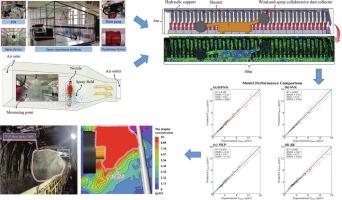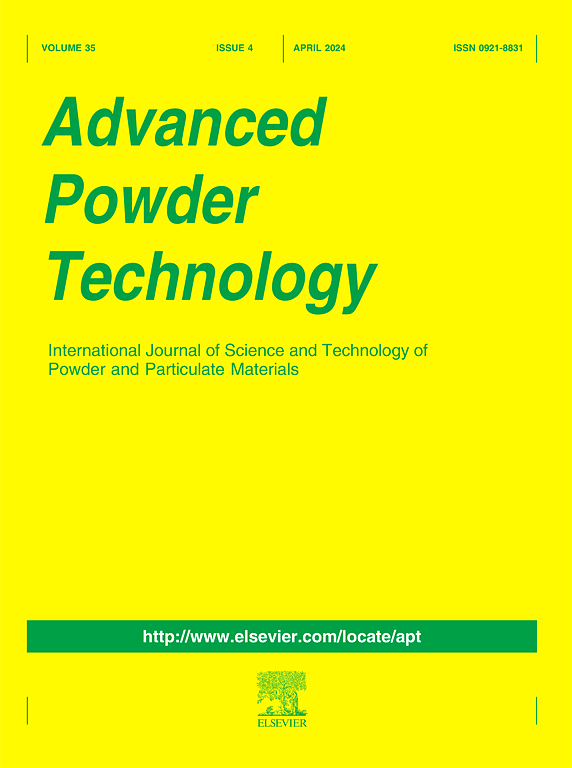Research on wind-spray synergistic dust removal technology in coal mine
IF 4.2
2区 工程技术
Q2 ENGINEERING, CHEMICAL
引用次数: 0
Abstract
The high concentration dust produced by coal mining seriously endangers the health of coal miners. This study presents an integrated computational-experimental framework for optimizing a wind-spray synergistic dust collector to enhance dust suppression efficiency at the coal face. An improved Euler-Lagrange model incorporating O’Rourke’s droplet collision algorithm was developed, reducing prediction error by 6.7 % compared to standard models. Systematic CFD simulations investigated the effects of seven operational parameters (spray pressure, nozzle diameter, fan velocity, and spray angles) on spray field characteristics. To enable comprehensive multi-parameter optimization, four machine learning (ML) algorithms were evaluated using a 500-sample dataset generated through Latin Hypercube Sampling. The Back-Propagation Neural Network (BPNN) demonstrated superior predictive performance (R2 = 0.981, RMSE = 0.33 g/m3, MAPE = 4.8 %) with excellent generalization capability (ΔRMSE = 0.03 g/m3). Global optimization employing the validated BPNN surrogate model with Sequential Quadratic Programming refinement identified optimal parameters, achieving 136.4 % improvement in average droplet concentration near the drum compared to baseline configurations. Field implementation of the optimized dual-collector system reduced dust concentration at the shearer driver’s position from 372 to 43.7 mg/m3, demonstrating 90.6 % removal efficiency. This integrated CFD-ML methodology provides a robust framework for industrial dust suppression optimization, with significant implications for coal mining safety.

煤矿风雾协同除尘技术研究
煤矿开采产生的高浓度粉尘严重危害着煤矿工人的身体健康。为提高采煤工作面抑尘效率,提出了一种优化风喷协同除尘器的综合计算-实验框架。结合O 'Rourke液滴碰撞算法,提出了一种改进的欧拉-拉格朗日模型,与标准模型相比,预测误差降低了6.7%。系统的CFD模拟研究了七个操作参数(喷雾压力、喷嘴直径、风扇速度和喷雾角度)对喷雾场特性的影响。为了实现全面的多参数优化,使用Latin Hypercube Sampling生成的500个样本数据集评估了四种机器学习(ML)算法。反向传播神经网络(BPNN)具有较好的预测性能(R2 = 0.981, RMSE = 0.33 g/m3, MAPE = 4.8%)和较好的泛化能力(ΔRMSE = 0.03 g/m3)。采用经过验证的BPNN代理模型和序列二次规划优化的全局优化确定了最优参数,与基线配置相比,桶附近的平均液滴浓度提高了136.4%。现场实施优化后的双捕集器系统后,采煤机驾驶员位置的粉尘浓度从372 mg/m3降至43.7 mg/m3,除尘效率为90.6%。这种集成的CFD-ML方法为工业粉尘抑制优化提供了一个强大的框架,对煤矿开采安全具有重要意义。
本文章由计算机程序翻译,如有差异,请以英文原文为准。
求助全文
约1分钟内获得全文
求助全文
来源期刊

Advanced Powder Technology
工程技术-工程:化工
CiteScore
9.50
自引率
7.70%
发文量
424
审稿时长
55 days
期刊介绍:
The aim of Advanced Powder Technology is to meet the demand for an international journal that integrates all aspects of science and technology research on powder and particulate materials. The journal fulfills this purpose by publishing original research papers, rapid communications, reviews, and translated articles by prominent researchers worldwide.
The editorial work of Advanced Powder Technology, which was founded as the International Journal of the Society of Powder Technology, Japan, is now shared by distinguished board members, who operate in a unique framework designed to respond to the increasing global demand for articles on not only powder and particles, but also on various materials produced from them.
Advanced Powder Technology covers various areas, but a discussion of powder and particles is required in articles. Topics include: Production of powder and particulate materials in gases and liquids(nanoparticles, fine ceramics, pharmaceuticals, novel functional materials, etc.); Aerosol and colloidal processing; Powder and particle characterization; Dynamics and phenomena; Calculation and simulation (CFD, DEM, Monte Carlo method, population balance, etc.); Measurement and control of powder processes; Particle modification; Comminution; Powder handling and operations (storage, transport, granulation, separation, fluidization, etc.)
 求助内容:
求助内容: 应助结果提醒方式:
应助结果提醒方式:


